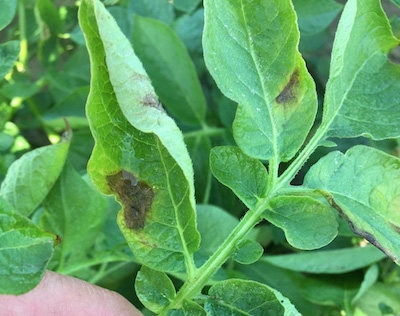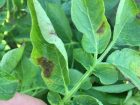
Features
Agronomy
Diseases
Late blight found near Alliston, Ont.
Late blight was found in a field near Alliston, Ont. on August 14, according to Eugenia Banks, potato specialist with the Ontario Potato Board.
August 22, 2018 By Potatoes in Canada
 Late blight was found on Aug. 14 near Alliston The same strain of late blight has been found in Ontario
Late blight was found on Aug. 14 near Alliston The same strain of late blight has been found in OntarioDespite negative results from spore trap filters for the area, Banks collected a sample from the potato field that “looked suspiciously like late blight, but there was negligible white, fuzzy growth on the underside of the leaves and almost no stem lesions.” The late blight found in the field was localized in one area and as of August 23, has not spread beyond its localized area.
On August 18, spore trap filters were positive – detecting spores of late blight – for the Alliston area. The spore traps from August 14, the day late blight was found through scouting, were sent to the lab and tested positive for late blight on August 16. However, there was a delay of at least 10 days between plant infection and catching spores in the spore traps. Banks suggests one of the reasons for the delay could be related to the negligible white fuzzy growth of late blight on the underside of the infected leaves. Also, the recent hot weather experienced in Ontario could’ve restricted sporulation.
Larry Kawchuck from Agriculture and Agri-Food Canada (AAFC) in Lethbridge, Alta. conducted a preliminary assessment of the late blight strain identification found in Ontario. Kawchuck, at first assessment, says the strain appears to be US 23.
US 23 also happens to be the strain identified in Michigan, Illinois and Wisconsin this year.
US 23 is still susceptible to Ridomil fungicide. Banks says Ridomil plus Kocide is a good tank mix for fields that will not be topkilled soon. Banks adds Revus is also an effective late blight specific fungicide. Potato growers in the area close to where late blight was detected are encouraged to apply a protective spray and monitor closely to prevent the spread of the disease to other areas.
In Wisconsin, late blight was confirmed in commercial potatoes in southern Adams County as well as northern Marquette County, according to Amanda Gevens, associate professor at the University of Wisconsin-Madison. Gevens says the lesions were hard to spot, but were classic with brown, water soaked discolouration on the stems and leaves had sporulation on leaf undersides.
Recent wet weather in Ontario helps keep leaves wet for late blight spore germination and infection. According to Banks, leaf lesions are usually visible three days after infection. Tubers near the surface may also become infected if spores produced on the leaves are washed down into the soil by rain or irrigation water.
Banks says rolling before applying herbicide is “a good practice to seal soil cracks to protect the tubers against late blight infection and to avoid greening.” In addition, growers should scout the wetter parts of fields: the edges, the low spots and pivot tracks.
Update: As of August 28, 2018, spore traps are still testing positive for spores of late blight in Alliston, Ont. Spore traps tested positive in the Shelburne-Melancthon area but only for one week – leading to specialists to suspect the it was a result of late blight spores from a nearby tomato home garden. A list of late blight fungicides can be found here.
Print this page
